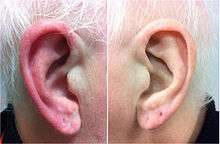Red ear syndrome

Red ear syndrome (RES) is a rare disorder of unknown etiology which was originally described in 1994. The defining symptom of red ear syndrome is redness of one or both external ears, accompanied by a burning pain.[1] A variety of treatments have been tried with limited success.[1]
Characteristics
Attacks of skin redness and burning pain in one or both external ears are the only common symptom.[1] Pain is often most pronounced at the ear lobe, and sometimes radiates to the jawbone and cheek.[1] The pain is normally mild, but has occasionally been described as severe.[1] The attacks can last seconds or hours, with 30 minutes to an hour being typical.[1] Most patients have daily attacks, ranging from 20 a day to a few a year.[1]
Causes
It is believed this syndrome may represent an auriculo-autonomic headache or be part of the group of disorders known as trigeminal autonomic cephalgias, which includes cluster headaches.[2][3] It is more often associated with migraine in younger people, while late-onset RES may result from pathology of the upper cervical spine or trigeminal autonomic cephalgia.[1]
Epidemiology
Red ear syndrome is considered rare, but the prevalence is unknown.[1] There are only about 100 cases described in the medical literature, with a male-to-female ratio of 1:1.25.[1] It has been reported in patients from ages 4 to 92, with an average onset at age 42.[1]
Management
Red ear syndrome has proven difficult to treat.[1] The most widely attempted medication is gabapentin, with one case series finding that seven of eight patients on gabapentin showed improvement in attack frequency and ear color.[1] Smaller studies have reported limited success in certain patients using amitriptyline, flunarizine, imipramine, verapamil, and propranolol.[1] Appropriate medication may differ depending on the underlying cause of the individual's symptoms.[4] Using an ice pack to cool the ear during an attack can provide relief.[1]
References
- 1 2 3 4 5 6 7 8 9 10 11 12 13 14 15 Lambru, G.; Miller, S. & Matharu, M. S. (2013). "The red ear syndrome". The Journal of Headache and Pain. 14 (1): 83. doi:10.1186/1129-2377-14-83.
- ↑ Purdy RA, Dodick DW (August 2007). "Red ear syndrome". Curr Pain Headache Rep. 11 (4): 313–6. doi:10.1007/s11916-007-0210-8. PMID 17686397.
- ↑ Brill TJ, Funk B, Thaçi D, Kaufmann R (December 2009). "Red ear syndrome and auricular erythromelalgia: the same condition?". Clin. Exp. Dermatol. 34 (8): e626–8. doi:10.1111/j.1365-2230.2009.03342.x. PMID 19489849.
- ↑ Ryan, S.; Wakerley, B. R. & Davies, P. (2012). "Red ear syndrome: A review of all published cases (1996–2010)". Cephalalgia. 33 (3): 190–201. doi:10.1177/0333102412468673.